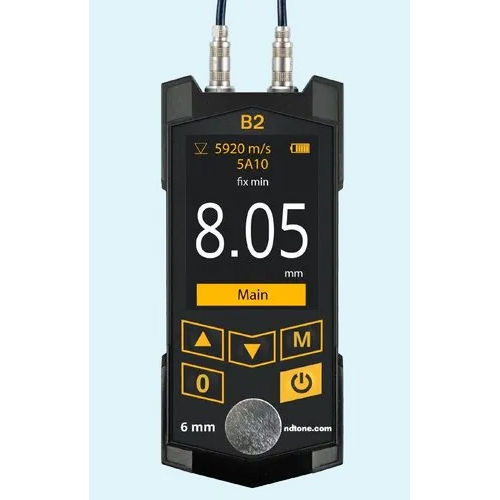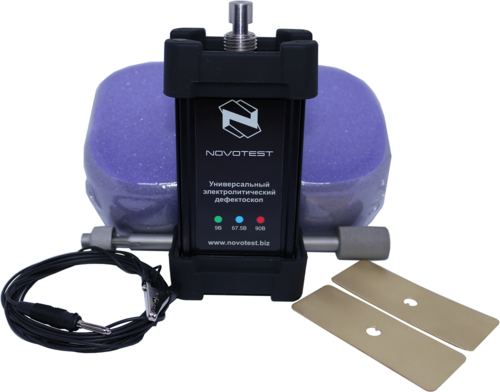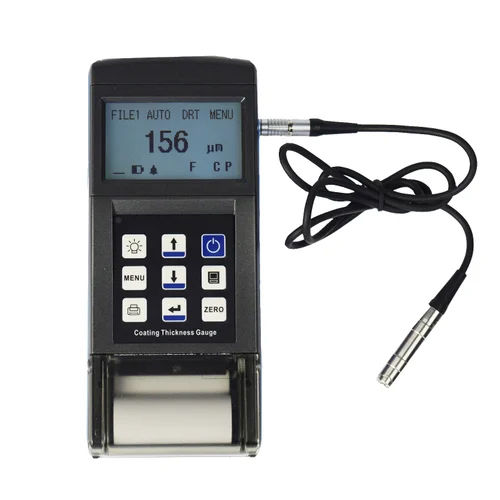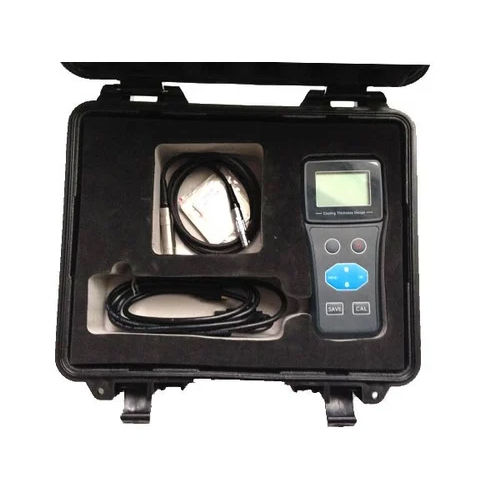Ultrasonic Digital Thickness Gauge B2 BY NDT1 KRAFT
200000 INR/Piece
Product Details:
- Measuring Range 1.2 mm to 225.0 mm
- Sensor Type Ultrasonic
- Outer Size Approx. 150 x 74 x 32 mm
- Frequency 5 MHz
- Display 4-digit display
- Case High Impact ABS Plastic
- Usage Industrial
- Click to View more
X
Ultrasonic Digital Thickness Gauge B2 BY NDT1 KRAFT Price And Quantity
- 1 Piece
- 200000 INR/Piece
Ultrasonic Digital Thickness Gauge B2 BY NDT1 KRAFT Product Specifications
- ABS Plastic
- Ultrasonic Digital Thickness Gauge
- Measurement of material thickness - metals, glass, plastics, pipes, tanks
- High Impact ABS Plastic
- Black
- Industrial
- 1.2 mm to 225.0 mm
- 0.1 % %
- 5 MHz
- 4-digit display
- Industrial
- Ultrasonic
- Approx. 150 x 74 x 32 mm
Ultrasonic Digital Thickness Gauge B2 BY NDT1 KRAFT Trade Information
- 100 Piece Per Month
- 7 Days
- All India
Product Description
An Ultrasonic Digital Thickness Gauge B2 BY NDT1 KRAFT is a device used to measure the thickness of various materials using ultrasonic technology. This type of gauge is commonly used in industries such as manufacturing, construction, automotive, and aerospace for quality control and inspection purposes.
Heres how it typically works:
1. Transducer: The gauge has a transducer that emits ultrasonic waves. These waves travel through the material being measured.
2. Reception of Signals: Once the ultrasonic waves encounter the opposite surface of the material or a boundary within the material, they bounce back towards the transducer.
3. Measurement: The gauge measures the time it takes for the ultrasonic waves to travel from the transducer, reflect off the materials surface or boundary, and return. Using the known speed of sound in the material, the gauge calculates the thickness of the material.
4. Display: The measured thickness is displayed digitally on the gauges screen, providing a precise reading.
Some key features of ultrasonic digital thickness gauges may include:
1. Multiple Measurement Modes: They may offer various measurement modes such as single-point, multiple-point, and scan mode for scanning large areas.
2. Memory: Many gauges have built-in memory to store measurement data for later analysis or documentation.
3. Calibration: They often come with calibration options to ensure accurate measurements across different materials and thickness ranges.
4. Data Output: Some gauges allow for data output, enabling connectivity to computers or other devices for further analysis or record-keeping.
5. Durability: Depending on the application, these gauges may be designed to withstand harsh environments or specific industrial conditions.
6. Portability: Many modern ultrasonic thickness gauges are compact and lightweight, making them easy to carry around for on-site inspections.
Ultrasonic Digital Thickness Gauge B2 BY NDT1 KRAFT FAQ:
Q. What is an ultrasonic digital thickness gauge?
Ans: An ultrasonic digital thickness gauge is a device used to measure the thickness of materials using ultrasonic waves. It emits ultrasonic pulses into the material and measures the time taken for the waves to bounce back, calculating the materials thickness.
Q. How does an ultrasonic thickness gauge work?
Ans: The gauge emits ultrasonic waves into the material being measured. These waves travel through the material until they encounter a boundary or the opposite surface. The gauge measures the time it takes for the waves to return, and using the known speed of sound in the material, calculates the thickness.
Q. What materials can an ultrasonic thickness gauge measure?
Ans: Ultrasonic thickness gauges can measure a wide range of materials including metals, plastics, glass, composites, and more. The materials acoustic properties determine the accuracy of the measurement.
Q. What are the advantages of using an ultrasonic thickness gauge?
Ans: Advantages include non-destructive testing, high accuracy, versatility in measuring various materials, ease of use, and portability for on-site inspections.
Q. How accurate are ultrasonic thickness gauges?
Ans: Accuracy depends on factors such as the quality of the gauge, calibration, surface conditions, and the material being measured. Generally, high-quality gauges can achieve accuracies within a few thousandths of an inch or microns.
Q. Can ultrasonic thickness gauges measure through coatings or paint?
Ans: Yes, some models of ultrasonic thickness gauges have capabilities to measure through coatings or paint layers on the surface of the material. This is particularly useful in industries where corrosion protection coatings are common.
Q. How do I calibrate an ultrasonic thickness gauge?
Ans: Calibration procedures vary depending on the manufacturer and model of the gauge. Typically, calibration involves using a set of reference samples with known thicknesses to adjust the gauges settings for accurate measurements.
Q. Are there any safety considerations when using ultrasonic thickness gauges?
Ans: While ultrasonic thickness gauges are generally safe to use, operators should follow safety guidelines provided by the manufacturer. This may include wearing appropriate personal protective equipment and ensuring proper handling of the device.
Q. Can ultrasonic thickness gauges measure temperature?
Ans: Some advanced models of ultrasonic thickness gauges may have temperature compensation features to account for changes in material properties due to temperature variations. However, direct temperature measurement is not a standard function of these gauges.
Q. Are ultrasonic thickness gauges suitable for use in all environments?
Ans: Ultrasonic thickness gauges are versatile and can be used in various environments. However, extreme temperatures, high levels of humidity, or hazardous conditions may require specialized gauges designed for such environments.
Robust and User-Friendly Design
Constructed using high-impact ABS plastic, the B2 BY NDT1 KRAFT Ultrasonic Digital Thickness Gauge ensures durability and ease of handling in demanding industrial environments. Its light weight and compact size make it convenient for both field and workshop applications, and data hold functionality allows for effortless reading retention during measurements.
Precision Measurements Across Materials
Delivering exceptional accuracy with a resolution of 0.1 mm, this gauge is suitable for diverse materials, including metals, glass, and plastics. The wide measuring range from 1.2 mm to 225.0 mm allows for versatile usage across pipes, tanks, and various industrial components, facilitating quality control and maintenance processes.
Convenient Operation and Versatile Power
Powered by just two AA batteries, the Ultrasonic Digital Thickness Gauge offers dependable operation with a low battery indicator for timely replacement. The device supports both single and dual-point calibration, enabling users to attain higher measurement accuracy according to specific material requirements.
FAQs of Ultrasonic Digital Thickness Gauge B2 BY NDT1 KRAFT:
Q: How does the B2 BY NDT1 KRAFT Ultrasonic Digital Thickness Gauge operate?
A: The gauge utilizes ultrasonic waves generated by its piezoelectric transducer to measure the thickness of materials. After placing the transducer probe on the surface, sound pulses are transmitted through the material, and the device calculates thickness based on the time taken for the echo to return.Q: What types of materials can be measured using this thickness gauge?
A: This device is suitable for measuring various solid materials including metals, glass, plastics, pipes, and tanks, making it highly adaptable for different industrial applications such as maintenance, quality assurance, and safety inspections.Q: Where can I use the Ultrasonic Digital Thickness Gauge B2 BY NDT1 KRAFT?
A: You can use this gauge in industrial settings within the operating temperature range of 0C to 40C. It is especially useful in workshops, factories, construction sites, and during installation or inspection of pipelines and storage tanks.Q: What is the calibration process for this device?
A: The B2 BY NDT1 KRAFT supports both single and dual-point calibration. Users can calibrate the device by using standard reference samples or known material thicknesses to ensure measurement accuracy, especially when switching between different materials.Q: When should I replace the batteries in the gauge?
A: The device operates on two AA batteries and features a low battery indicator. You should replace the batteries promptly once the indicator is activated to ensure uninterrupted and accurate operation.Q: What are the benefits of using this model for industrial applications?
A: Key benefits include high accuracy (0.1%), a broad measurement range, data hold functionality, and robust construction. These features contribute to efficient quality control, help prevent material failures, and ensure safety in industrial environments.Tell us about your requirement

Price:
Quantity
Select Unit
- 50
- 100
- 200
- 250
- 500
- 1000+
Additional detail
Mobile number
Email
 English
English Spanish
Spanish French
French German
German Italian
Italian Chinese (Simplified)
Chinese (Simplified) Japanese
Japanese Korean
Korean Arabic
Arabic Portuguese
Portuguese







